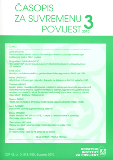Radić nakon Radića: Stvaranje kulta heroja Stjepana Radića (1928.-1934.)
RADIĆ AFTER RADIĆ: CONSTRUCTION OF STJEPAN RADIĆ’S HERO CULT (1928-1934)
Author(s): Stipica GrgićSubject(s): History
Published by: Hrvatski institut za povijest
Keywords: Stjepan Radić; January 6th Dictatorship; Political symbols; National ideology; Hero cult
Summary/Abstract: Stjepan Radić kept his position, as one of the beloved national symbols, even after his death and the population embraced his name as one of the saints in Croatian national Pantheon. His heart and brain were extracted from his body right after his death. These organs, as a set of strong icons, were meant to symbolize Radić’s love for the people and his ideals that would guide the Nation even after his death. But during the dictatorship of King Alexander and his successors these relics were never revealed and implemented, as Croatian Peasant Party leadership planed, in a grand mausoleum that would serve as the Croatian national place of memory. Nevertheless Radić’s name and character was recognized by the Croatian people as one of the symbols of “silent rebellion” against the bad treatments of the Dictatorship. Authorities became aware of that soon after the start of the new, heavy-handed regime. So they prohibited Radić’s name and figure on any object it was put with the excuse it could provoke outbursts of (Serbo-Croatian) “tribal hate” in, only nominally, onenation state. The objects with his portrait or name, which varied from pictures and badges through table cloths, handkerchiefs, hats, pocket mirrors and cigarette cases to chocolates and scythes, tell us how a person in a very short time can transform from a role of political leader to the position of national martyr.
Journal: Časopis za suvremenu povijest
- Issue Year: 42/2010
- Issue No: 3
- Page Range: 723-748
- Page Count: 26
- Language: Croatian

